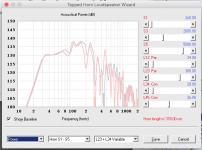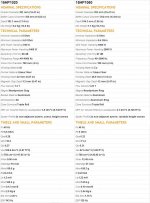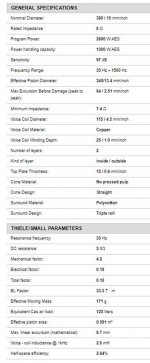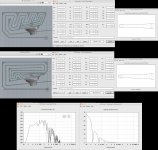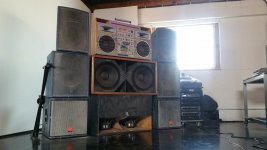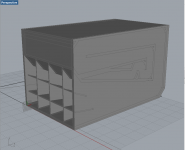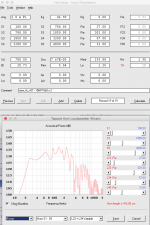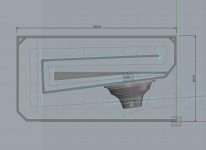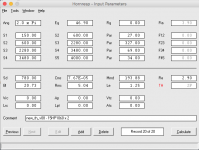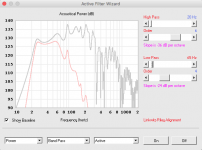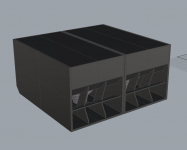This thread is AWESOME!
Any updates with the new sub design or tops, Jennygirl?
I'm interested on the tops as well
Another woofer option?
Many thanks for the replies. I also have a very nice RCF LF15N451 15" driver.
Would this also work in this design?
I've never used HornResp before and feel a little daunted with the folding process so please excuse me for wanting to try and use an existing, proven design.
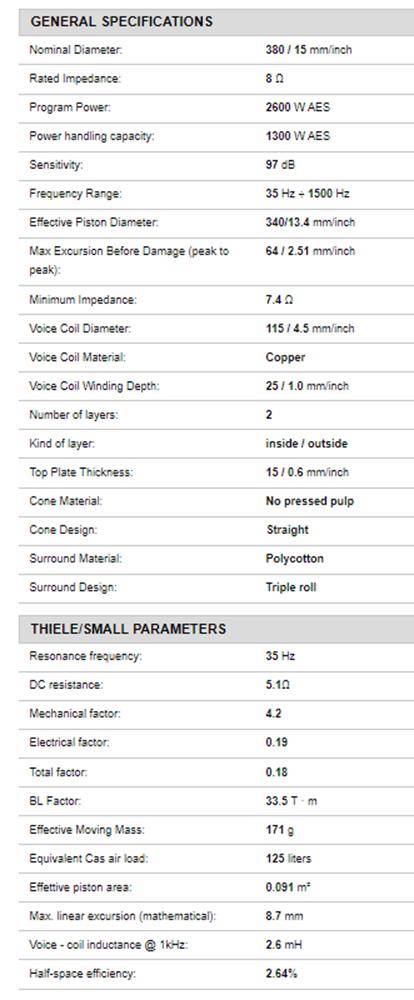
Again, really appreciate any help.
Many thanks for the replies. I also have a very nice RCF LF15N451 15" driver.
Would this also work in this design?
I've never used HornResp before and feel a little daunted with the folding process so please excuse me for wanting to try and use an existing, proven design.
Again, really appreciate any help.
Attachments
Also looks fine at first glace. I expect any high-power PA subwoofer would do the job just fine.
However, note that this design is tuned somewhere low, near 30Hz. It also has fairly high sensitivity, which means you only need a few hundred watts before you reach Xmax.
If you go for a higher tuning (THAM15), you'll get lots more output, but lose that low-frequency extension.
For PA use, I find full power at 40Hz to be adequate for pretty much anything that comes up in my line of work. If you want to play modern EDM or dubstep, then going to 30Hz is worthwhile. Otherwise, 40Hz will do fine.
Chris
However, note that this design is tuned somewhere low, near 30Hz. It also has fairly high sensitivity, which means you only need a few hundred watts before you reach Xmax.
If you go for a higher tuning (THAM15), you'll get lots more output, but lose that low-frequency extension.
For PA use, I find full power at 40Hz to be adequate for pretty much anything that comes up in my line of work. If you want to play modern EDM or dubstep, then going to 30Hz is worthwhile. Otherwise, 40Hz will do fine.
Chris
Hey guys!! What's up?! Sorry I left for a bit. Life happens 
Anyway, working on some new enclosure plans for the 15HP1060s & figured I'd share. Currently I am working on a bigger setup and using the sub I built here for 45hz and below. I figured I might as well really go for it on the low low end.
Also still have that desire to put a bit of a flare at the very end of the horn to see if it does anything for coupling and/or dispersion of sound.
Going for 25hz!
I do have some questions, namely if it's dangerous to have S1 reduced to almost nothing? Also can anyone see any reason to go with either folding pattern over the other besides construction difficulty?
I hope you have all been well It's good to be back here!
It's good to be back here!
Anyway, working on some new enclosure plans for the 15HP1060s & figured I'd share. Currently I am working on a bigger setup and using the sub I built here for 45hz and below. I figured I might as well really go for it on the low low end.
Also still have that desire to put a bit of a flare at the very end of the horn to see if it does anything for coupling and/or dispersion of sound.
Going for 25hz!
I do have some questions, namely if it's dangerous to have S1 reduced to almost nothing? Also can anyone see any reason to go with either folding pattern over the other besides construction difficulty?
I hope you have all been well
Attachments
OOh I knew there was a simple answer. Thanks BP1 for saving me the digging! I was shooting for 2:1 CR so I am happy to hear this 
Still tweaking and need to do advanced centerline on the horn path, but it looks like I'll probably be building the simpler of the two, and splitting up into two cabs.
Cheers
Still tweaking and need to do advanced centerline on the horn path, but it looks like I'll probably be building the simpler of the two, and splitting up into two cabs.
Cheers
Attachments
Hey stranger,
You are designing with parabolic segments, navigate to the segment length input box and use the P key to change the Con to Par. A few years back I made a similar TH and found it to be really nice all around, we even used it for outdoor movies.
HI DAN!
Weird, I thought I had it set to parabolic. I must have forgotten to redo that setting on a subsequent sim. Thanks for pointing that out! Luckily no major difference to FR!
Attachments
For a dual-fold TH, you'd have a much easier build and less internal wasted space if you go with an SS15 type of fold. You can always move the mouth around if you want the TH to be deeper rather than higher.
There's a workbook on my site that can help get the optimum dimensions for an SS15 fold.
Considering the driver that you're using, I'd suggest measuring its impedance curve, then using that to determine the semi-inductance parameters, then using those in Hornresp sim (check the Hornresp thread for more details, though I will likely be putting up a page on my site about semi-inductance tomorrow if I get the time). The result should be a more accurate sim.
There's a workbook on my site that can help get the optimum dimensions for an SS15 fold.
Considering the driver that you're using, I'd suggest measuring its impedance curve, then using that to determine the semi-inductance parameters, then using those in Hornresp sim (check the Hornresp thread for more details, though I will likely be putting up a page on my site about semi-inductance tomorrow if I get the time). The result should be a more accurate sim.
Brian- semi inductance sounds very interesting. I would like to learn about that. It seems that I have some reading and more simming to do before I get to building. Thank you!
As for the SS15 type of fold, I am indeed familiar. The first THs I built were two of jbell's stadium horns, followed by the TH in the main design referenced throughout this thread which I think all are what you're referring to as well.. correct me if I'm wrong and apologies if so! I know I definitely don't understand what you mean by moving the mouth around to make it deeper?
I guess I always have some dumb constraint or thing that I'm trying to do with my builds. Maybe I'm just trying to make it unique, maybe it'll actually be useful, or maybe I am just making things harder for myself.. but here I have chosen to stick with a roughly 24"w x 24-26"h front dimension (61cm x 61-66cm) and however deep [dimension] it needs to be for compliance with a 25hz L3 and the 15HP1060.
'Perhaps' even more dumb is my final constraint for an air–coupling flare at the very end of the horn (contained within the nominal bounds of the enclosure) which seems to disturb most normal looking folding patterns I have tried and severely complicates the build. I am thinking (or rather hoping) that some of these constraints/ideas will lead to other special benefits or opportunities down the line with this particular build.
Thanks for the feedback
As for the SS15 type of fold, I am indeed familiar. The first THs I built were two of jbell's stadium horns, followed by the TH in the main design referenced throughout this thread which I think all are what you're referring to as well.. correct me if I'm wrong and apologies if so! I know I definitely don't understand what you mean by moving the mouth around to make it deeper?
I guess I always have some dumb constraint or thing that I'm trying to do with my builds. Maybe I'm just trying to make it unique, maybe it'll actually be useful, or maybe I am just making things harder for myself.. but here I have chosen to stick with a roughly 24"w x 24-26"h front dimension (61cm x 61-66cm) and however deep [dimension] it needs to be for compliance with a 25hz L3 and the 15HP1060.
'Perhaps' even more dumb is my final constraint for an air–coupling flare at the very end of the horn (contained within the nominal bounds of the enclosure) which seems to disturb most normal looking folding patterns I have tried and severely complicates the build. I am thinking (or rather hoping) that some of these constraints/ideas will lead to other special benefits or opportunities down the line with this particular build.
Thanks for the feedback

I know I definitely don't understand what you mean by moving the mouth around to make it deeper?
SS15-type fold THs tend to be higher than they are deep. You can switch this around by (1) rotating the TH around so where mouth was going to be is now at the bottom of the enclosure, and (2) what was the bottom is now the front. Cut a hole the same size as the mouth is supposed to be at the bottom of the new front of the enclosure and you've effectively moved the mouth.
I have chosen to stick with a roughly 24"w x 24-26"h front dimension (61cm x 61-66cm) and however deep [dimension] it needs to be for compliance with a 25hz L3 and the 15HP1060.
That should be possible to do, though the enclosure might end up being a bit deep. Just bear in mind that THs are limited-bandwidth devices. An F3 of 25 Hz would mean that the upper usable limit of the TH might be around 60 Hz. Yes, the FR graph might look usable above there, but check the GD and phase graphs
Brian- thanks for getting back so fast 
That's an interesting folding idea, I totally get what you're saying! I had not thought of that! The only issue I see with it is to do with my "perhaps most dumb" constraint to have an air coupling flare contained within the nominal rectangular profile of the horn. Rotating the mouth as such would appear to leave an abrupt 90deg turn at the very end of the horn and I can't see where I'd put a flare at the very end without adding something [literally] outside of the box.
Probably the best thing I can see with the SS15 folding is that it breaks up the size of the boards and would probably require much less bracing?
I do think we are on the same page as far as understanding about frequency range. This cab is for dedicated sub bass response in an otherwise excellent sounding setup (from ~43hz and up). 25-60hz range is ideal.
After looking through semi inductance (all that I could easily find at least), I found a parallel strategy which involves tuning a box geared for LF a bit lower still... and then I ended up finding that I could use the necessary filters not only keep the driver within xmax, but cross at the frequency that suits the cabinet's purpose as a sub bass box, and also flatten response curve across the cabinets useful band. A bit of a triple symbiotic relationship.
Here is a look at the sim. I should note that 120cm is about the longest depth dimension that I want to go. Luckily, extending the cabinet, lengthening the horn path, and adjusting the cross sectional areas really favored a simpler fold. However, many of these panels are massive and thus I would plan on having to use some pretty extensive bracing.
That's an interesting folding idea, I totally get what you're saying! I had not thought of that! The only issue I see with it is to do with my "perhaps most dumb" constraint to have an air coupling flare contained within the nominal rectangular profile of the horn. Rotating the mouth as such would appear to leave an abrupt 90deg turn at the very end of the horn and I can't see where I'd put a flare at the very end without adding something [literally] outside of the box.
Probably the best thing I can see with the SS15 folding is that it breaks up the size of the boards and would probably require much less bracing?
I do think we are on the same page as far as understanding about frequency range. This cab is for dedicated sub bass response in an otherwise excellent sounding setup (from ~43hz and up). 25-60hz range is ideal.
After looking through semi inductance (all that I could easily find at least), I found a parallel strategy which involves tuning a box geared for LF a bit lower still... and then I ended up finding that I could use the necessary filters not only keep the driver within xmax, but cross at the frequency that suits the cabinet's purpose as a sub bass box, and also flatten response curve across the cabinets useful band. A bit of a triple symbiotic relationship.
Here is a look at the sim. I should note that 120cm is about the longest depth dimension that I want to go. Luckily, extending the cabinet, lengthening the horn path, and adjusting the cross sectional areas really favored a simpler fold. However, many of these panels are massive and thus I would plan on having to use some pretty extensive bracing.
Attachments
Does anyone have experience with cowls on TH's? I am so very curious if this will affect near field vertical dispersion one bit. I suppose at such low frequencies I'll probably be hearing the room more than anything else, but perhaps there is an effect? Can something look so good that it ends up sounding better? 
Serious thought though: given the increased linearity+length of the horn folds along the end of the throat combined with the cowl something tells me yes... (this has been my thought all along)
Serious thought though: given the increased linearity+length of the horn folds along the end of the throat combined with the cowl something tells me yes... (this has been my thought all along)
Attachments
- Status
- This old topic is closed. If you want to reopen this topic, contact a moderator using the "Report Post" button.
- Home
- Loudspeakers
- Subwoofers
- FaitalPRO 15HP1060 vs 3015LF for tapped horn?
